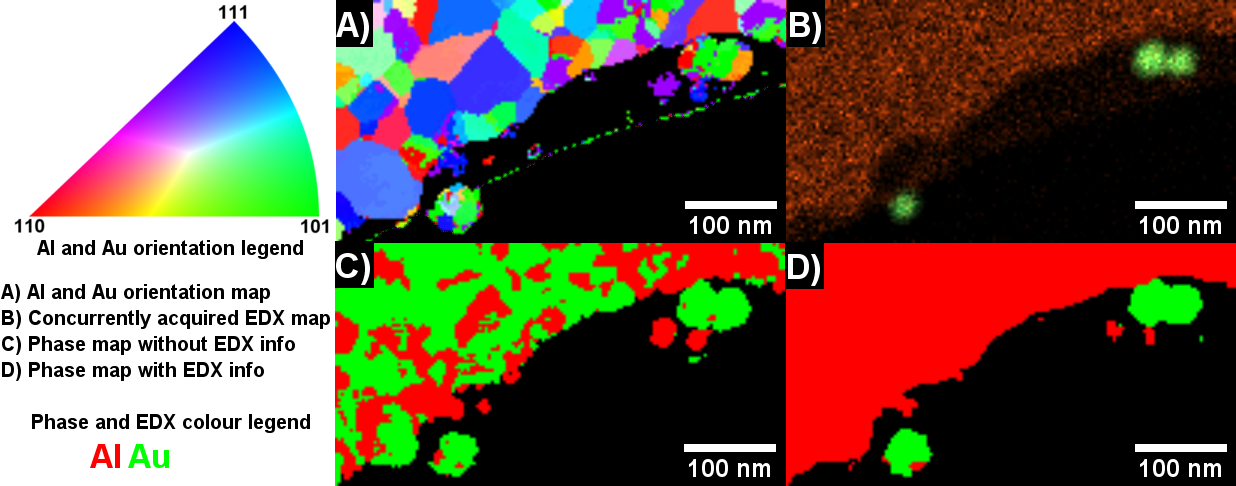Adding another dimension to 4D-STEM with EDX-assisted crystal orientation and phase mapping
- Abstract number
- 75
- Presentation Form
- Poster
- DOI
- 10.22443/rms.mmc2023.75
- Corresponding Email
- [email protected]
- Session
- Poster Session One
- Authors
- Dr. Rob Hooley (1), Mr. Eduardo Serralta (1), Dr. Tomáš Morávek (1), Dr. Raman Narayan (2), Dr. Jing Lu (2), Dr. JK Weiss (2), Dr. Narendraraj Chandran (1)
- Affiliations
-
1. TESCAN Brno s.r.o
2. TESCAN Tempe LLC
- Keywords
4D-STEM, automated analysis, EDX, precession, direct electron detector, orientation and phase analysis, ACOM
- Abstract text
4D-STEM crystal orientation and phase mapping is a powerful technique for the nanocharacterisation of materials, as it can provide simultaneous information on phase distributions, grain size, and crystal orientation. However, it can be challenging to separate phases with similar lattice parameters and symmetries (lattice parameter difference of <5%). EDX mapping can be used to separate phases with different chemical compositions but cannot provide crystal orientation information. A combined method leveraging both 4D-STEM and EDX mapping can reduce fitting errors when using between similar phases though this requires synchronisation between scanned electron beam precession, EDX acquisition and a camera for analytical 4D-STEM acquisitions.
In this study, a polycrystalline aluminium foil with added gold nanoparticles was analysed using EDX-assisted 4D-STEM phase analysis. The aluminium and gold exhibit similar lattice constants of 4.049 Å, and 4.078 Å respectively. The integration of scanning, electron beam precession with dedicated fast precession coils, EDX, and Dectris Quadro direct electron detector in the TESCAN TENSOR instrument enabled the collection of high-quality precession diffraction data with rich chemical information. The seamless synchronisation of these components allows for a streamlined and efficient data collection process. To differentiate between aluminium and gold, the chemical information obtained from EDX was utilised to assign weights to the phases in the diffraction pattern matching algorithm, resulting in a more robust phase analysis. By leveraging the chemical information, it was possible to distinguish between phases with similar crystal structures but different compositions, such as aluminium and gold, despite a lattice parameter difference of less than 5%.
Analytical 4D-STEM datasets consisting of simultaneous EDX and precession assisted 4D-STEM were measured on a TESCAN TENSOR 100 kV STEM, using the Explore user interface for probe and precession alignment, data acquisition, and on-the-fly pattern indexing with kinematical templates. A beam current of 50pA was used with a precession angle of 0.4 degrees. Datasets were collected with and without EDX assistance for phase mapping, their processed orientation and phase maps are shown in Figure 1. The acquisition and processing parameters were otherwise the same for both datasets.
It can be seen from the images in Figure 1, that adding the EDX data to the phase mapping algorithm greatly assisted with the identification of the correct phase, and this can be backed up by observing the distribution of aluminium and gold in the simultaneously acquired EDX map. However, care must be taken to ensure sufficient characteristic X-ray counts from the known phases are present to avoid spurious identification. The orientation data is not significantly changed, as both display the same cubic crystal structure and use the same orientation legend, however there is now higher confidence that the correct phase is being used for indexing.
Figure 1 – A) 4D-STEM orientation map of aluminium and gold specimen B) simultaneously acquired EDX map C) phase map without EDX assistance and D) phase map using EDX assistance.
- References
E. Rauch et al, Automated nanocrystal orientation and phase mapping in the transmission electron microscope on the basis of precession electron diffraction, Z. Kristallogr. 225, 2010, 103–109.
I. MacLaren et al, A comparison of a direct electron Detector and a High-Speed Video Camera for a Scanning Precession Electron Diffraction Phase and Orientation Mapping, Microscopy and Microanalysis 26, 2020, 1–7.
C.L. Chen et al, The combined use of EBSD and EDX analyses for the identification of complex intermetallic phases in multicomponent Al–Si piston alloys, Journal of Alloys and Compounds 490, 2010, 293-300.

